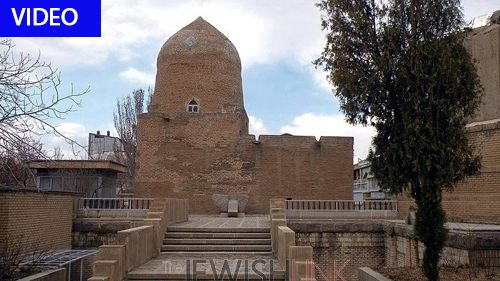
For centuries, Iranian Jews, particularly women praying for fertility, venerated the modest brick shrine. The first detailed accounts in the historical record are from Christian tourists in the 1800s and early 1900s. These records, which include outstanding illustrations, descriptions, and even photographs, were recently digitized–and provide a rare glimpse into the condition of the shrine in the past and the particular observances once held there.
One 19th-century visitor describes a marble plaque on the interior dome walls claiming that the structure was dedicated in the year 714 CE (Jewish calendar year 4474) by “?the two benevolent brothers Elias and Samuel, sons of Ismail Kachan.” Other visitors describe rooms covered in pilgrims’ graffiti in various languages as well as darkened by candle smoke; a stork’s nest sitting atop the shrine’s dome; and a prayer area within that was designed to enable worshippers to face the tombs and Jerusalem at same time.
They also recount that notes in Hebrew script were placed near the tombs, similar to how Jewish worshippers often tuck prayer notes into the stones of Jerusalem’s Wailing Wall. For Iranian Jews, who could only reach Jerusalem with great difficulty, the shrine served as a stand-in place at which to pray and weep.
ntil the 1970s, the shrine was hidden away in a crowded part of Hamadan, surrounded by houses, and only accessible through a narrow dirt alley. But in 1971, in honor of a national celebration of 2,500 years of Iranian monarchy, the Iranian Jewish Society commissioned architect Yassi (Elias) Gabbay to undertake a renovation.
Houses around the tomb were purchased and demolished, making the shrine accessible from the main street via a bridge Gabbay constructed over the new courtyard and a partially-underground synagogue chapel he also built, to complete the shrine complex. The subterranean chapel has a skylight in the shape of a Star of David that can be seen in Google Earth, quite possible making the Islamic Republic in Iran home to the only Jewish Star visible from space.
The renovation did not significantly alter the shrine itself, or the grave stones cluttering the plaza outside the old shrine. (Some prominent local Jews had in the past secured burial plots outside the shrine, which they considered holier than plots in the main Jewish cemetery in Hamadan.)
One of the old structure’s remarkable features that Gabbay preserved is its front door, a massive piece of granite with a hidden lock. Less than four feet high, the stunted doorframe forces visitors to bow as they enter, in deference to the site’s holy occupants.
An outer chamber holds tombs of famous rabbis and provides access by means of an archway to the interior chamber. The interior chamber features Hebrew writing along the walls and holds two carved sarcophagi, supposedly marking the burial spots of Esther and Mordecai. This chamber also houses a cabinet with a 300-year-old Torah scroll.
Today, Esther’s Tomb has lost some of its former splendor. Iranian authorities, for example, have removed an ornamented gate Gabbay had erected along the sidewalk using a geometric motif common in many mosques. The problem? Part of the classic motif forms a Jewish Star–a fact regime officials apparently considered intolerable (unlike the fence, the Star of David skylight is not visible from street level). Gabbay himself lives in exile, having fled the Islamic Revolution and restarted his architectural practice in Los Angeles, though he dreams of returning to see the site he transformed.
The question of whether the shrine actually marks the resting place of Esther and her uncle remains unanswered, and is perhaps unanswerable.
myjewishlearning.com
)